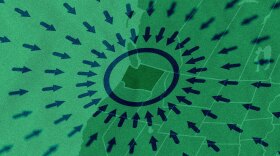Paul Allen, a co-founder of Microsoft, is more than doubling his investment in unraveling mysteries of the brain – and bringing some of America’s top scientists to a new lab in Seattle. They say they're building "brain observatories," where they hope to answer big questions about how the mind works.
They'll peer inside the brain, similar to how groups of astronomers gather at major observatories to peer into the stars for answers about the formation of the universe.
The idea was also inspired by big physics projects – where dozens of researchers work in teams to answer fundamental questions.
With the brain observatories, they’ll try to figure out, literally, how the brain works. How do we "see" something, and then become aware of it, make decisions about it, and take action? The Allen-funded scientists will take these questions down to the level of individual brain cells and the molecules inside the cells.
Comprehensive look at the brain
Scientists around the world are already working on aspects of these questions. But, so far, nobody has attempted to bring together all the different ways of studying the brain under one roof, and work as a team with one goal.
Allen has committed $300 million over the next four years, which will pay for new lab spaces, a doubling of the staff as the Allen Institute for Brain Science, and moving some of the stars of America's neuroscience community to Seattle. One is Christof Koch, of Caltech, and another is Clay Reid, of Harvard Medical School.
Paul Allen says he’s always been fascinated by how the workings of the human brain:
"I'm awed by its enormous complexity. Our brains are many magnitudes more advanced in the way they work than any computer software that’s every been invented."
Allen put a chunk of his Microsoft wealth a decade ago into creating his brain research institute in Seattle’s Fremont neighborhood. He says the new work builds on the efforts since 2003 to create several brain "atlases" that shows how each portion of the brain is linked with specific genes. That atlas is available for free on the internet.
But much of that previous work focused on building research tools and reference materials. The new initiative pushes into more fundamental scientific questions.
"We believe that this initiative signals the arrival of large-scale science in a field that is populated by small groups. It will require rewarding the team, rather than a few lead investigators, for its collective effort," Koch and Reid write in the journal Nature, in announcing the new project.
While they're focusing on pure science, Allen says he hopes what they learn could have practical uses:
"For me it's both fascinating, and as someone who has also been touched by the impact of neurodegenerative diseases--my mother has Alzheimer’s for example--I want to see cures of those things brought forward for the benefit of everybody."
The mouse visual system
They plan to tackle this enormous problem by focusing more narrowly on the part of the brain that's already the most studied: the visual system. More specifically, the mouse visual system.
How could studying how a mouse sees teach us about the human mind?
The mouse visual system is like a stripped down, simplified version of what you find in humans – but it uses most of the same components and structures.
(Introduction to the Allen Institute for Brain Science:)
http://youtu.be/e74pCJmd07s
Competition
In Europe, a similarly audacious proposal is competing to get $1.3 billion in funding. It would attempt to create a computer model that integrates everything that's been published about how the brain works. This "Human Brain Project" has engendered a lot of hostility from other scientists who fear it will absorb all of the research funding and leave alternative approaches starving.
“Our response is that funding agencies are already spending billions of dollars on many smaller projects across all areas of biomedical research, and the Allen Institute wants to pioneer a new approach," write Koch and Reid.
Plus, they have at least four years of funding already set, thanks to Allen's largesse.
An overview look at the brain from Nature:
http://www.youtube.com/watch?v=dS_ONoUrptg







